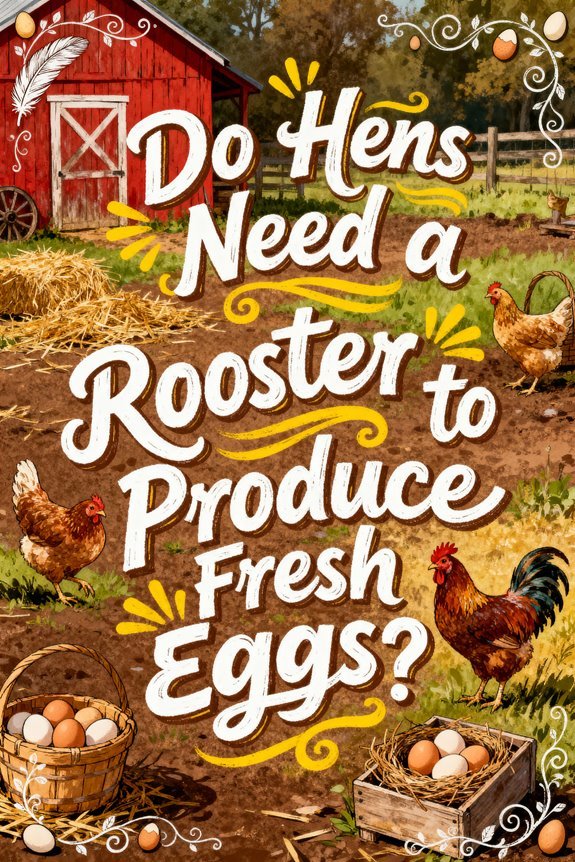Do Hens Need a Rooster to Produce Fresh Eggs?
No, you don’t need a rooster for your hens to produce fresh eggs. Hens naturally lay eggs through a 24-26 hour process driven by hormones, daylight exposure, and nutrition – not male fertilization. Your hens will start laying at 18-22 weeks of age and can produce 4-6 eggs weekly during peak periods with proper care. A rooster’s presence only matters if you want fertilized eggs for hatching chicks. Understanding the complete egg-laying cycle reveals fascinating biological processes.
The Natural Egg-Laying Process in Hens
While hens can lay eggs without a rooster present, understanding their reproductive system reveals a complex biological process. Your hen’s natural ovary function relies on a single functional ovary on her left side, containing thousands of developing yolks. When mature, these yolks release individually into the oviduct segments to begin egg formation. The most productive laying occurs when hens receive 16 hours of light daily.
You’ll find the egg’s journey through distinct oviduct segments takes 24-26 hours. The process starts in the infundibulum, moves to the magnum where egg white forms over 3-4 hours, continues through the isthmus for membrane development, and finishes in the shell gland. Here, the shell forms over 20-21 hours. Just before laying, the egg rotates to position its larger end first, ensuring proper delivery of your fresh egg.
Common Myths About Roosters and Egg Production
Many backyard poultry keepers still cling to persistent myths about roosters’ role in egg production, despite clear scientific evidence to the contrary. You’ll find several rooster myths that need debunking: hens don’t need males to lay eggs, fertilized eggs taste identical to unfertilized ones, and roosters can’t influence egg size or quantity. Most hens naturally begin sexual maturity stage around 18-22 weeks of age.
The truth is that egg behaviors are governed by hens’ natural hormonal cycles, daylight exposure, and overall health. Your hens will lay eggs regardless of whether you keep a rooster, as egg production is entirely independent of male presence. Most healthy hens can produce 5 to 6 eggs weekly under optimal conditions. Scientific studies confirm that a rooster’s only contribution is fertilization for potential chick development. When managing your flock, focus on proper nutrition, environmental conditions, and hen care rather than myths about roosters’ influence on egg laying. While roosters serve important roles in a flock by providing predator protection and defense, this has no direct impact on egg production.
The Real Purpose of Roosters in a Chicken Flock
Despite not being necessary for egg production, roosters serve multiple valuable functions in a chicken flock. Their rooster behavior encompasses critical protective duties, including predator detection, sounding alarms, and guarding hens during vulnerable activities like nesting and dust bathing.
In terms of flock dynamics, roosters maintain social order by preventing bullying among hens and establishing clear hierarchies. They’re instrumental in reducing stress levels and facilitating the integration of new birds. Maintaining a proper ratio of hens helps prevent overbreeding and ensures harmony within the flock. You’ll find they improve management efficiency by helping train hens to return to the coop and keeping the group together during free-ranging activities.
A rooster’s presence creates a more secure environment where hens experience less stress, potentially leading to more consistent laying patterns and better overall flock productivity. They also enable natural flock growth through fertilized eggs, supporting sustainable poultry operations.
Understanding Fertile vs. Infertile Eggs
Since fertilization affects egg development, understanding the differences between fertile and infertile eggs is essential for both breeders and backyard chicken keepers. Fertile eggs display a distinctive “bullseye” pattern on the yolk, where the blastoderm forms concentric circles around a germinal disk. In contrast, infertile eggs show only a simple blastodisc without rings. You can identify fertile eggs through candling after a week of incubation by looking for dark, spider web-like veins indicating embryonic development. Regular mating with a rooster ensures consistent egg fertility over a 10-14 day period.
While these biological differences are significant for breeding, they don’t affect the egg’s nutritional value or taste. Both fertile and infertile eggs contain identical levels of vitamins, minerals, proteins, and fats. Scientific research has disproven claims that fertile eggs offer superior nutrition or different flavor profiles.
Essential Requirements for Healthy Egg Production
Three core elements drive successful egg production in hens: balanced nutrition, proper lighting, and ideal housing conditions. Your nutrition management should include 16-20% protein in layer feed and 2.5-3.5% calcium through sources like oyster shells. Hens need 14-16 hours of light daily to maintain consistent laying cycles, which you can achieve through natural or artificial lighting. LED light fixtures are recommended for their efficiency and reliability in supplementing natural daylight.
Environmental conditions greatly impact productivity. Provide 1.5-2 square feet of floor space per hen and guarantee proper ventilation. You’ll need to offer free-choice calcium supplements and grit for best digestion. Start providing calcium supplements around 18-20 weeks of age when hens begin laying. Watch for heat stress, which can reduce laying rates and egg quality. Combat this by supplementing with antioxidant vitamins E and C. Regular monitoring of your flock’s health will help you detect and address production issues early. Select prolific layer breeds like Leghorns for maximum egg production.
Benefits and Drawbacks of Keeping Roosters
While roosters aren’t necessary for egg production, they offer several compelling benefits for your flock’s overall health and safety. A rooster’s vigilant behavior includes warning hens of predators through specific alarm calls and even confronting threats directly. Their presence stabilizes flock dynamics by maintaining social order and reducing aggressive disputes among hens. Free range space helps minimize confrontations between multiple roosters.
However, rooster behavior can present significant challenges. They crow throughout day and night, potentially violating noise ordinances and disturbing neighbors. Aggressive mating can cause feather damage and stress in hens, while territorial tendencies may complicate handling. You’ll need to weigh these drawbacks against benefits like enhanced flock protection, improved social harmony, and the ability to produce fertilized eggs for sustainable breeding purposes.
Maximizing Egg Production Without a Rooster
To maximize egg production without a rooster, you’ll need to focus on four key management areas: nutrition, lighting, stress reduction, and environmental conditions.
Implement feeding strategies that include 16-20% protein content and calcium supplements like oyster shell for strong eggshells. Maintain 14-16 hours of consistent light daily, using artificial lighting during shorter winter days. Reduce stress through habitat enrichment with perches and dust baths, while keeping the flock’s social structure stable. Create a well-ventilated, draft-free environment with clean nesting boxes placed in quiet areas.
Select productive breeds like Leghorns or Rhode Island Reds for ideal laying performance. You’ll achieve peak production between 6 months and 2-3 years of age, regardless of rooster presence, as hens naturally lay unfertilized eggs with proper care and management. Daily egg collection ensures that eggs remain fresh and unfertilized, preventing any potential embryo development.
Creating the Perfect Nesting Environment
Creating an ideal nesting environment starts with properly sized boxes that match your hens’ dimensions. You’ll need boxes approximately 12 inches in each dimension for standard breeds, with a 4-inch front lip to prevent eggs from rolling out. Mount your nest boxes 12-18 inches above the coop floor, ensuring they’re positioned in darker, enclosed areas for maximum hen comfort. A minimum of two boxes is necessary for every three hens to prevent overcrowding and ensure consistent egg production. Bantam breeds require smaller boxes of about 10 inches in each dimension for optimal comfort.
For proper nest box placement, install a 6-inch perch in front of each entrance and limit vertical stacking to three levels for easy accessibility. You’ll need adequate nesting materials – at least 4 inches of clean, dry bedding like straw or wood shavings. Adding privacy curtains can create a secluded environment that encourages more frequent laying. Consider brooding considerations by making boxes slightly larger (16+ inches tall) if you’re planning for sitting hens. Maintain egg cleanliness by replacing bedding regularly and ensuring your coop design includes overhanging roofs to keep nest boxes dry.
The Science Behind Daily Egg Formation
The intricate process of egg formation takes place over a precise 24-26 hour cycle within a hen’s reproductive system. Your hen’s single functional ovary releases one mature yolk daily through ovulation, following extensive yolk synthesis in her liver. The developing yolk contains precise ratios of lipids (36%) and proteins (17%), including essential maternal antibodies. Once released, the yolk travels through your hen’s oviduct, where it spends about 15 minutes in the infundibulum. The magnum then adds protective albumen layers over 3-4 hours, followed by membrane formation in the isthmus. The final and longest stage occurs in the shell gland, where calcium carbonate deposits form the protective shell over approximately 20 hours. During shell formation, proper nutrition is crucial to provide the 4 grams of calcium needed for each eggshell. This methodical process continues daily throughout your hen’s peak laying period. Healthy hens require adequate space requirements of 3-4 square feet each to maintain optimal egg production.
Making Informed Decisions for Your Backyard Flock
When establishing a backyard flock, you’ll need to navigate multiple regulatory, spatial, and care requirements to guarantee success. Start by researching local regulations and HOA rules, particularly regarding flock composition and rooster restrictions. Most urban areas allow hens but prohibit roosters due to noise concerns. Their calm friendly disposition makes them particularly well-suited for suburban and urban settings.
Popular breeds like Rhode Island Red chickens make excellent choices for backyard flocks. For peak egg production, consider starting with 3-6 hens, which can provide 12-30 eggs weekly. You won’t need a rooster for egg-laying, as hens naturally produce unfertilized eggs. Plan to dedicate 10-20 minutes daily for essential care tasks like feeding, watering, and collecting eggs. Your coop must be weatherproof, ventilated, and predator-resistant, with separate nesting boxes and adequate space per bird. Weekly maintenance includes thorough cleaning and bedding replacement to prevent disease and maintain flock health.



